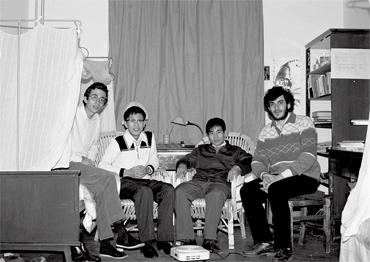In the summer of 1981, Cavazzuti was a second-year student of Chinese studies at the University of Venice, when he and several classmates were accepted into a Chinese language program at Nanjing University, Jiangsu Province. Getting there was an epic journey: the students took a train from Milan to Calais, France, a ferry to Dover, England, a train to London, a flight to Hong Kong, a hovercraft to Guangzhou, and train to Nanjing.
“What I learned in college had little to do with the real China. At college we were taught about Confucius, Mencius and such,” Cavazzuti told NewsChina. His first assigned reading at the University of Venice was “Liang Hui-wang,” a chapter from Mencius, a collection of conversations, anecdotes and interviews by the Confucian philosopher Mencius (372-289 BCE).
“The copies we used were printed from the traditional Chinese version. In many parts, the black ink was so thick that the characters were completely illegible. When asked to summarize the chapter, every one of us told a different story because we all made it up,” the photographer recalled with a grin.
“Later we also read Lu Xun (1881-1936). So, when I first arrived in China, the vocabulary I used was outdated or too literary.”
Beyond literature, the ubiquitous propaganda slogans and symbols posted around China’s cities left a lasting impression on Cavazzuti.
Cavazzuti intended to capture a side of China rarely seen by the outside world and arrived with his camera and lots of film. After six weeks at Nanjing University, the young man traveled to neighboring cities and towns to photograph whatever caught his eye.
“The environment of China was very ‘transparent’ at the time – everything was on display. I could easily capture people in their truest and most sincere states,” Cavazzuti said.
At a time when China saw few foreigners, it was impossible for Cavazzuti to photograph inconspicuously. He would either wait several hours for gawking crowds to leave or wear disguises.
In 1982, Fudan University, Beijing Foreign Studies University and Shandong University offered 16 two-year government-funded scholarships to college students from Italy. Cavazzuti was among four Italian students accepted to Fudan University. His monthly stipend was 140 yuan (US$22), far more than the average monthly income of Shanghai’s working class.
Cavazzuti spent most of the money on photography and travel. Over the next two years, he traveled to Suzhou, Chengdu, Kunming and Xiamen and even Sanya, Hainan Province, which had not yet opened to foreign visitors. He converted his dorm room closet into a tiny darkroom.
“China is a treasure trove of intricate stories and kaleidoscopic scenes. What intrigued me most was digging them out,” Cavazzuti said.
His work has no intended messages, ideas or explanations, he said. Rather, they are impressions of an exotic world he slowly absorbed.
Cavazzuti vividly captures scenes of everyday life in 1980s China: two smiling girls wearing the same fashionable dress and leather sandals walk hand-in-hand in a park in Qingdao, Shandong Province (1981). A newlywed Beijing couple smiles while leaning against a Chinese-made Hongqi sedan (1981). A snack bar owner in Xiamen, Fujian Province sits at a table while his wife knits a sweater (1981) and in a teahouse in Shanghai, a young man with a mop-top haircut talks excitedly with his friend while holding a cigarette (1983).
“[Cavazzuti] can always capture a quintessential Chinese happiness – even the mannequins in the storefronts he shot have a typical 1980s smile,” painter Chen Danqing wrote in the preface for At Ease.
“Andrea Cavazzuti’s photos show our past selves, how we struggled to break free from shackles, and cautiously step into real life,” best-selling Chinese author Yu Hua (To Live) wrote in a blurb for Cavazzuti’s book.
Li Jing told NewsChina that photography from mid-20th century China is seeing a comeback, such as the work from documentarians Henri Cartier-Bresson, Marc Riboud, Liu Xiangcheng, Akiyama Ryoji and Ren Shulin. In 2020, Unnamed, a photo collection of over 1,500 photos showing life in China from the 1950s to the late 1980s was a surprise hit. Compiled by Jin Yongquan, editor-in-chief of Popular Photography, all the photos in Unnamed are anonymous, salvaged from recycling stations and junk stores.
“People are longing for memories,” Li told the reporter. “Particularly during a time when our lives are besieged with digital information, our sense and feeling for tangible things is becoming increasingly fuzzy.”
“People’s expressions, personalities and values have changed. The tangible past has faded, and it’s instinctive for people to seek things from their past,” Li added.

 Old Version
Old Version


